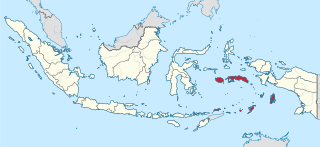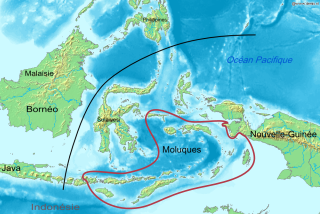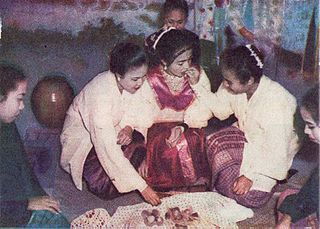Related Research Articles
In addition to its classical and modern literary form, Malay had various regional dialects established after the rise of the Srivijaya empire in Sumatra, Indonesia. Also, Malay spread through interethnic contact and trade across the south East Asia Archipelago as far as the Philippines. That contact resulted in a lingua franca that was called Bazaar Malay or low Malay and in Malay Melayu Pasar. It is generally believed that Bazaar Malay was a pidgin, influenced by contact among Malay, Hokkien, Portuguese, and Dutch traders.

Maluku is a province of Indonesia. It comprises the central and southern regions of the Maluku Islands. The largest city and capital of Maluku province is Ambon on the small Ambon Island. It is directly adjacent to North Maluku, Southwest Papua, and West Papua in the north, Central Sulawesi, and Southeast Sulawesi in the west, Banda Sea, Australia, East Timor and East Nusa Tenggara in the south and Arafura Sea, Central Papua and South Papua in the east. The land area is 57803.81 km2, and the total population of this province at the 2010 census was 1,533,506 people, rising to 1,848,923 at the 2020 census, the official estimate as at mid 2023 was 1,908,753. Maluku is located in Eastern Indonesia.
The Sawai language is a South Halmahera language of the Austronesian language family spoken in the Weda and Gane Timor districts of southern Halmahera, northern Maluku Province, Indonesia. There are approximately 12,000 speakers.

Alfur, Alfurs, Alfuros, Alfures, Aliforoes, Alifuru or Horaforas people is a broad term recorded at the time of the Portuguese seaborne empire to refer all the non-Muslim, non-Christian peoples living in inaccessible areas of the interior in the eastern portion of Maritime Southeast Asia, mainly from the Arafura Sea area.

The Central Malayo-Polynesian languages (CMP) are a proposed branch in the Malayo-Polynesian subgroup of the Austronesian language family. The languages are spoken in the Lesser Sunda and Maluku Islands of the Banda Sea, in an area corresponding closely to the Indonesian provinces of East Nusa Tenggara and Maluku and the nation of East Timor, but with the Bima language extending to the eastern half of Sumbawa Island in the province of West Nusa Tenggara and the Sula languages of the Sula archipelago in the southwest corner of the province of North Maluku. The principal islands in this region are Sumbawa, Sumba, Flores, Timor, Buru, and Seram. The numerically most important languages are Bima, Manggarai of western Flores, Uab Meto of West Timor, and Tetum, the national language of East Timor.

The Wemale people are an ethnic group of Seram Island, Indonesia. They number over 7,500 and live in 39 villages of the central area of the island. Like the Alune people in the west, the Wemale people originate from a common ancestral group called the Patasiwa.
The Aru languages are a group of a dozen Austronesian languages spoken on the Aru Islands in Indonesia. None are spoken by more than ten thousand people. Although geographically close to Central Maluku languages, they are not part of that group linguistically.
The Central Maluku languages are a proposed subgroup of the Central–Eastern Malayo-Polynesian branch of the Austronesian language family which comprises around fifty languages spoken principally on the Seram, Buru, Ambon, Kei, and the Sula Islands. None of the languages have as many as fifty thousand speakers, and several are extinct.
The Piru Bay languages are a group of twenty Malayo-Polynesian languages, spoken on Ambon Island and around Piru Bay on the island of Seram, Indonesia. None of the languages have more than about twenty thousand speakers, and several are endangered with extinction.

Moluccans are the Austronesian-speaking and Papuan-speaking ethnic groups indigenous to the Maluku Islands, Eastern Indonesia. The region was historically known as the Spice Islands, and today consists of two Indonesian provinces of Maluku and North Maluku. As such, "Moluccans" is used as a blanket term for the various ethnic and linguistic groups native to the islands.
Kei is an Austronesian language spoken in a small region of the Moluccas, a province of Indonesia.
Ternate is a language of northern Maluku, eastern Indonesia. It is spoken by the Ternate people, who inhabit the island of Ternate, as well as many other areas of the archipelago. It is the dominant indigenous language of North Maluku, historically important as a regional lingua franca. A North Halmahera language, it is unlike most languages of Indonesia which belong to the Austronesian language family.

Lisela or Rana people is an ethnic group mostly living on Indonesian island Buru, as well as on some other Maluku Islands. They belong to the eastern Indonesian anthropological group and are sometimes referred to as northern Buru people. From an ethnographic point of view, Lisela are similar to other indigenous peoples of Buru island. They speak the Lisela language.
Kayeli is an extinct Austronesian language once used by the Kayeli people of the Indonesian island Buru. Two dialects were recognized, namely Leliali (Liliali) and Lumaete.
Lisela, also called Li Enyorot, is an Austronesian language; in 1989 it was spoken by about 11,900 Lisela people mostly living in the northern part of Indonesian island Buru. It is also preserved among the small Lisela community on the Ambon Island.
Banda is an Austronesian language of the Central Maluku subgroup. Along with Kei, it is one of the two languages of the Kei Islands in the Indonesian province of Maluku.
Manusela is an Austronesian language spoken in Seram, Indonesia. It is classified by Collins (1983) as a member of the Central Maluku subgroup.
Kamarian is an extinct Austronesian language. It was spoken at the southwestern coast of Seram Island in the Moluccas in eastern Indonesia.
Sapalewa River, also Sapolewa, is a river of Seram Island, Maluku province, Indonesia, about 2400 km northeast of the capital Jakarta.
The Eti River is a river of Seram Island, Maluku province, Indonesia, about 2400 km northeast of the capital Jakarta. It flows into the sea on the southwest side of the island, a few kilometres south of the town of Piru, West Seram Regency.
References
- 1 2 Wemale at Ethnologue (25th ed., 2022)

- ↑ Collins, James T. (1983). The Historical Relationships of the Languages of Central Maluku, Indonesia. Pacific Linguistics D-47. Canberra: Australian National University. doi:10.15144/PL-D47.
- ↑ List of languages in Indonesia